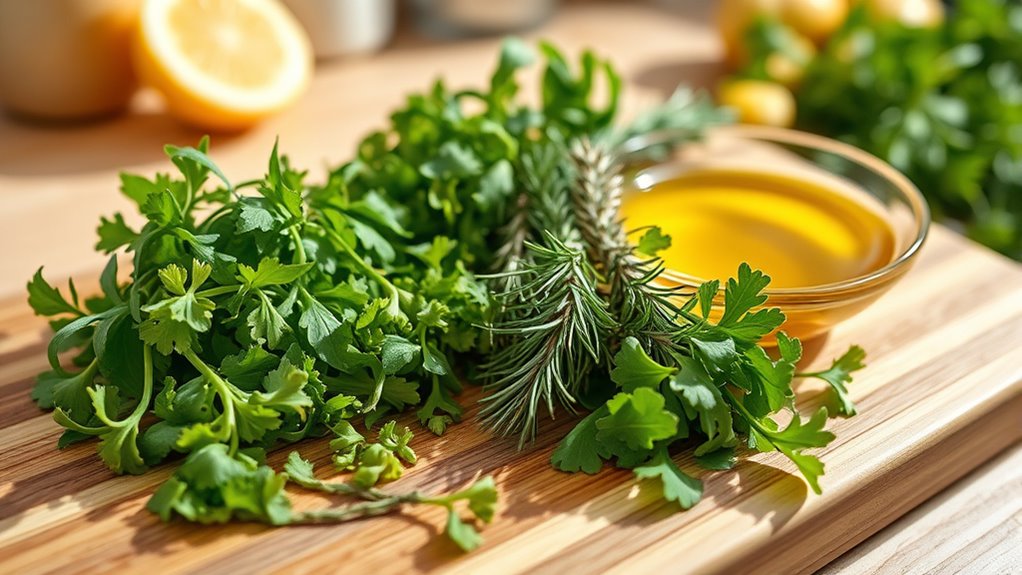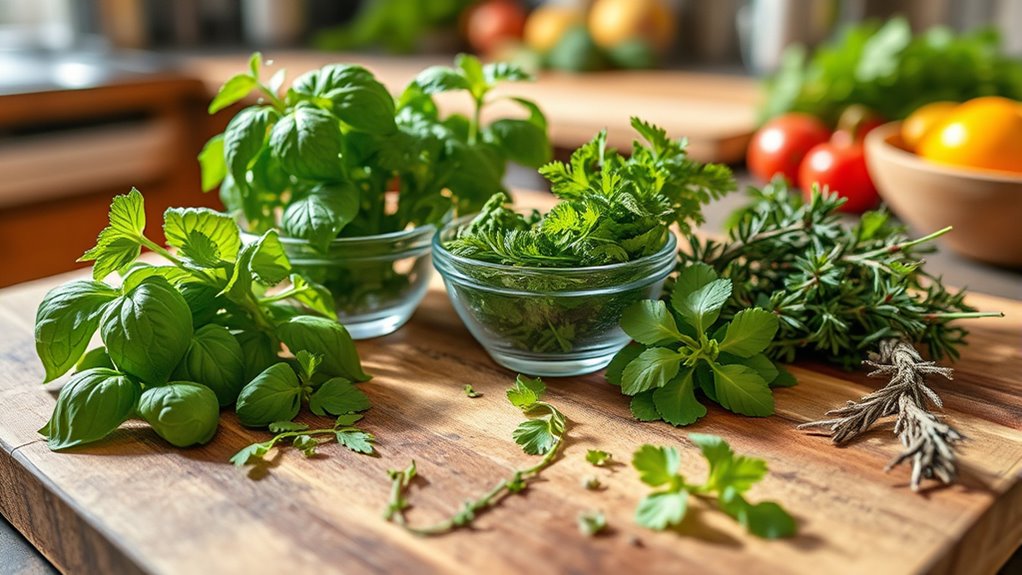To match fresh flavors like a chef, start with classic pairings such as basil with tomato or rosemary with garlic, which naturally enhance each other. Experiment with contrasting herbs like mint and lemon or thyme and sage to add complexity. Infuse herbs into oils and vinegars to maximize their flavor impact. Use fresh, high-quality herbs and taste as you go to refine your blends. Keep exploring these techniques, and you’ll discover how to create harmonious herb combinations effortlessly.
Key Takeaways
- Start with classic pairings like basil and tomato or rosemary and garlic to build a solid flavor foundation.
- Experiment with contrasting herbs such as mint and lemon to add brightness and complexity to dishes.
- Use fresh, high-quality herbs and infuse them into oils or vinegars for enhanced, layered flavors.
- Consider cultural culinary traditions to inspire authentic herb combinations and enhance dish harmony.
- Taste and adjust infusions gradually to achieve the perfect balance without overpowering flavors.

Are you looking to elevate your dishes with the perfect herb combinations? Mastering culinary herb combinations can transform simple ingredients into extraordinary meals. The key is understanding how different herbs work together to enhance flavors without overpowering each other. Start by experimenting with classic pairings like basil and tomato, or rosemary and garlic. These combinations work because their flavors complement and balance each other, creating a harmonious taste. As you gain confidence, explore more complex pairings, blending herbs with contrasting notes—such as mint and lemon or thyme and sage—to add layers of flavor to your dishes. Remember, the goal is to create a synergy that elevates your culinary creations, so don’t be afraid to try new combinations.
Experiment with classic and contrasting herb pairings to elevate your culinary creations naturally.
In addition to combining herbs thoughtfully, mastering herbal infusion techniques can further enhance your dishes. Infusing herbs into oils, vinegars, and broths allows you to extract maximum flavor and aroma, giving your meals a sophisticated touch. Start simple by adding fresh herbs like rosemary or thyme to warm oils, letting them steep gently to release their essential oils. Strain and use these infused oils in dressings, marinades, or drizzled over roasted vegetables. You can also infuse vinegars with herbs such as basil or tarragon, which then add depth to salads and sauces. These techniques are straightforward but require a bit of patience—time allows the flavors to meld, resulting in richer, more vibrant tastes.
To get the most out of your herbal infusion techniques, use high-quality fresh herbs, and pay attention to timing. Longer infusions tend to develop more complex flavors, but overdoing it can lead to bitter notes. Taste as you go, and remember that subtlety is often more impactful than intensity. When combining herbs for culinary purposes, keep in mind their individual flavor profiles and how they interact. For example, delicate herbs like chervil or dill work well with lighter dishes, while robust herbs like rosemary or oregano suit hearty fare. Always consider the dish’s overall flavor profile to ensure your herb combinations and infusions complement the main ingredients.
Additionally, understanding the cultural context of herbs and their traditional pairings can inspire more authentic and creative combinations, especially when experimenting with international cuisines. In essence, the secret to matching fresh flavors like a chef lies in understanding both culinary herb combinations and herbal infusion techniques. With a bit of experimentation and patience, you’ll develop a keen sense for which herbs enhance each other and how to extract their best qualities. Over time, you’ll build a personalized herb palette that adds depth and sophistication to your cooking, making every meal a flavorful masterpiece.
Frequently Asked Questions
How Do I Balance Strong Herb Flavors With Delicate Dishes?
Balancing bold herbs with delicate dishes requires careful moderation. You should use strong herbs sparingly to avoid overpowering subtle flavors. Add them gradually, tasting as you go, to achieve delicate flavor enhancement without overwhelming the dish. Remember, the goal is to complement, not dominate. By balancing bold herbs thoughtfully, you enhance the dish’s complexity while preserving its delicate nuances, creating a harmonious and well-rounded flavor profile.
Can Herb Pairings Vary Based on Cooking Methods?
Did you know that different cooking methods can change how herbs taste? Yes, herb pairings can vary based on cooking techniques like sautéing, roasting, or boiling. Using herb drying techniques or herbal infusion methods, you can enhance flavors to suit each method. For example, delicate herbs blend better with gentle cooking, while robust herbs stand out in roasted dishes. Adjust your herb pairings accordingly to maximize flavor harmony.
Which Herbs Are Best for Vegetarian or Vegan Dishes?
When choosing herbs for vegetarian or vegan dishes, focus on herb flavor profiles that enhance plant-based ingredients. Fresh herbs like basil, cilantro, parsley, and mint work well, offering bright, aromatic notes. These plant-based herb combinations elevate dishes with vibrant, fresh flavors. Keep in mind, balancing the herbs’ intensity with other ingredients creates a harmonious dish. Experiment with different herb pairings to discover unique, delicious flavor combinations that complement your vegetarian or vegan meals.
How Do I Store Fresh Herbs to Preserve Flavor?
Imagine your herbs as precious jewels—preserve their sparkle! To keep fresh herbs flavorful, you should use dry herb storage methods like wrapping them in a damp paper towel and placing them in a plastic bag or jar in the fridge. For best fresh herb preservation, trim the stems and store upright in a glass of water, then cover loosely. This keeps herbs vibrant and flavorful longer.
Are There Any Herbs That Should Be Avoided Together?
When considering herb conflicts, you should avoid incompatible herb combinations that could overpower or clash. For example, sage and basil can sometimes be too strong together, while dill may not pair well with strong flavors like rosemary. Trust your palate and experiment carefully, but steer clear of mixing herbs known for conflicts, as it can ruin your dish’s harmony. Always research herb compatibility to improve your culinary creations.
Conclusion
Now that you’ve uncovered these herb pairings, your dishes will never be the same. But there’s so much more to explore—hidden combinations that could elevate your cooking even further. Are you ready to experiment beyond the basics and reveal flavor secrets only seasoned chefs know? Keep experimenting, and you might discover your signature herb blend. The kitchen is waiting—what delicious surprise will you create next? The possibilities are endless, and your culinary adventure is just beginning.









